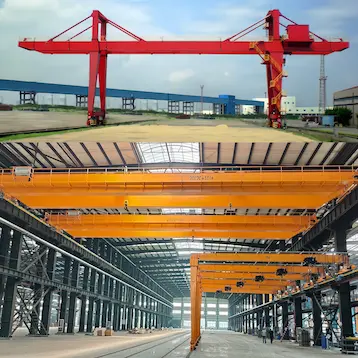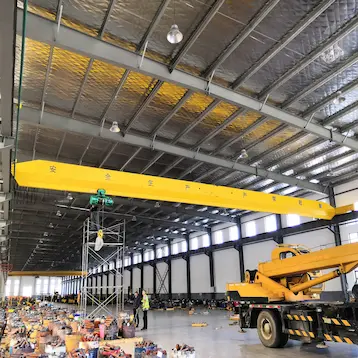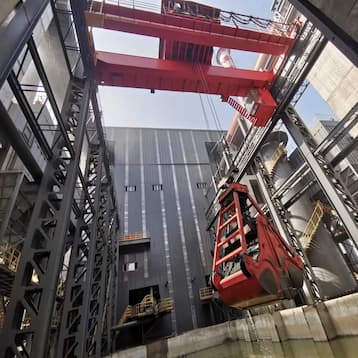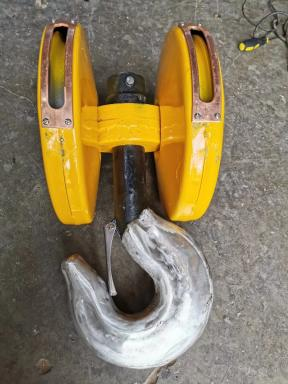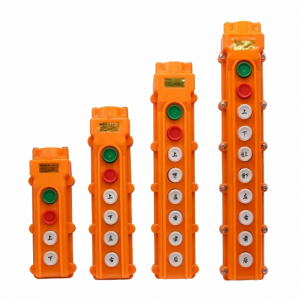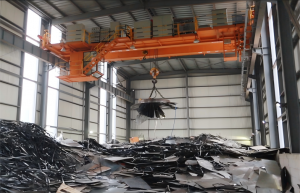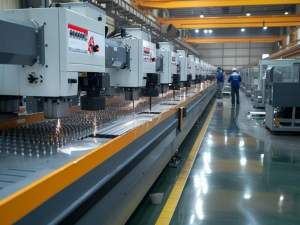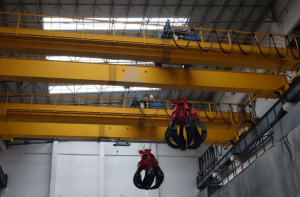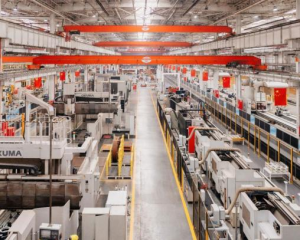Blog
- Home
- Blog
Overhead Cranes: Types, Prices, and Global Case Studies
I. What Is an Overhead Crane?
A crane is defined as a fixed mechanical device used for short-distance handling of small to medium loads, available in various types and designs.
An overhead crane primarily consists of one or two girders that move along two parallel rails mounted on opposite walls. The crane provides three axes of movement through the hoist on the bridge and the trolleys on either side:
•The hoist moves the load up and down.
•The trolley moves the load left and right.
•The bridge girder moves the load forward and backward.
This three-axis movement enables precise positioning and efficient material handling in workshops, warehouses, and industrial facilities.
II. Working Principle
The working principle of an overhead crane relies on three main mechanisms—the bridge (main girder), the trolley, and the hoist—moving along their respective tracks to achieve vertical, lateral, and longitudinal handling and positioning of loads.
The primary movements include:
•The bridge moves longitudinally forward and backward along rails installed on the sides of the workshop.
•The trolley moves horizontally left and right along the bridge rails.
•The hoist hook, using wire ropes or chains, moves vertically up and down.
Together, these motions enable the crane to perform material picking, handling, and unloading operations efficiently.
III. Common Types of Overhead Cranes
1. Single-Girder Overhead Crane (LD):
The single-girder light overhead crane features a compact structure and high overall rigidity, making it one of the most widely used crane types in the light crane category. It is typically paired with CD, MD, or HC electric hoists and is mainly used for light to medium lifting tasks. The rated lifting capacity generally ranges from 1 ton to 20 tons.
Specifications:
•Lifting Capacity: 1–20 t
•Span: 7.5 m – 28.5 m
•Lifting Height: 6 m / 9 m / 12 m / 18 m / 24 m / 30 m
•Duty Class: A3
•Rated Voltage: 220V / 380V / 400V / 415V / 660V, 50–60 Hz, 3-phase AC
•Control Mode: Ground control / Remote control
2. Low Headroom Overhead Crane (European Single-Girder & New Chinese Single-Girder, LDC)
The low headroom overhead crane is specifically designed for facilities where vertical headroom is limited. Its specially optimized structure allows the hook to reach as close as possible to the bottom of the main girder when lifted to the maximum height.
This design minimizes the required headroom while maximizing the effective lifting height, making it an ideal solution for workshops or operational areas with restricted overhead space.
Specifications:
•Lifting Capacity: 1–20 t
•Span: 7.5 m – 28.5 m
•Lifting Height: 6 m / 9 m / 12 m / 18 m / 24 m / 30 m
•Duty Class: A3
•Rated Voltage: 220V / 380V / 400V / 415V / 660V, 50–60 Hz, 3-phase AC
•Control Mode: Ground control / Remote control
3. Explosion-Proof Overhead Crane (LB, QB)
The explosion-proof single-girder crane is based on the standard overhead crane model but features enhanced performance of explosion-proof motors and electrical components, along with additional mechanical safety protections.
These key features effectively prevent fire and explosion hazards, ensuring safe operation in explosive environments. The explosion-proof grade is designated by the mark “Ex”.
Specifications:
•Lifting Capacity: 1 t / 2 t / 3 t / 5 t / 10 t / 16 t / 20 t
•Lifting Height: 6 m / 9 m / 12 m / 18 m / 24 m
•Duty Class: A3
•Explosion-Proof Grade: Exd IIB T4, Exd IIC T4
•Rated Voltage: 220V / 380V / 400V / 415V / 660V, 50–60 Hz, 3-phase AC
•Control Mode: Ground control / Remote control
4. Double-Girder Hoist Trolley Overhead Crane (QD)
The double-girder overhead crane features two parallel main girders as its core structure, providing additional support and operational stability for the entire crane.
Thanks to this structural design, the crane can handle heavier loads while maintaining structural rigidity and durability, effectively extending the service life of the equipment.
Specifications:
•Lifting Capacity: 5 – 800 t
•Span: 10.5 m – 40.5 m
•Lifting Height: 12 m – 60 m
•Duty Class: A3 – A8
•Rated Voltage: 220V – 690V, 50–60 Hz, 3-phase AC
•Control Mode: Ground control / Remote control / Cabin control
5. Double-Girder Trolley Overhead Crane (LH)
The double-girder trolley overhead crane consists of four main components: the electric hoist trolley, the bridge girder, the bridge travel mechanism, and the electrical control system.
The lifting mechanism uses a fixed wire rope electric hoist, and the crane can be operated via cabin control or ground remote control, offering flexible, convenient, and safe operation. Variable frequency (VFD) control can be added if required to enhance performance.
Specifications:
•Lifting Capacity: 5 – 32 t / 5 t
•Span: 10.5 m – 31.5 m
•Lifting Height: 3 m – 50 m
•Duty Class: A3, A4
•Rated Voltage: 220V – 690V, 50–60 Hz, 3-phase AC
•Crane Control Mode: Ground control / Remote control / Cabin control
IV. Core Components of an Overhead Crane
1. Main Girder:
The main girder serves as the primary horizontal beam of the overhead crane, spanning across the rails on both sides. It is supported by end beams and the bridge travel mechanism, moving along rails installed on the building structure.
The hoist and trolley assemblies are mounted on the main girder, playing a crucial role in lifting and moving loads. Its robust construction ensures stability and strength, allowing the crane to precisely handle heavy materials.
2. End Beams:
The end beams are installed at both ends of the bridge, providing support and mobility for the crane. They are equipped with wheels that run along the rails, as well as motors and gears responsible for driving these wheels.
Their sturdy design allows the bridge to move smoothly along the runway, ensuring optimal performance and load-bearing capacity.
3. Hoist:
The hoist is the key component responsible for lifting and lowering loads. Mounted on the main girder, it consists of a motor, drum, and wire rope.
The motor drives the drum, which winds the wire rope to raise or lower the load. The hoist can be operated manually or via remote control, providing flexibility and convenience for operators.
4. Trolley:
The trolley is mounted on the hoist and allows the load to move horizontally along the bridge. It is equipped with wheels that run along the length of the bridge, driven by a motor, and can be operated manually or via remote control.
Its precise and controlled movement enhances the crane’s versatility and efficiency, enabling accurate load positioning.
5. Crane Gearbox:
The crane gearbox is responsible for transmitting power from the motor to the crane’s wheels or other moving components. It consists of gears and shafts that convert the motor’s rotational motion into the speed and torque required for crane operation.
The gearbox ensures smooth and controlled movement of the crane, enabling precise load handling.
6. Crane Motor:
The crane motor serves as the power source of the overhead crane, providing the necessary energy for its operation. It is characterized by high efficiency, reliability, and precise control.
The motor converts electrical energy into mechanical energy, enabling the crane to perform lifting, lowering, and horizontal movement tasks.
7. Lifting Attachments:
The lifting attachments are a critical part of the crane, providing secure connection points for loads. They are typically forged from high-strength alloy steel to withstand heavy loads.
Lifting attachments are designed with safety latches or locking mechanisms to prevent accidental release of the load. Common forms include hooks, electromagnetic lifters, and magnetic plates, with specific types and specifications varying according to the nature of the material and load being handled.
8. Controller:
The crane controller is a handheld device used to operate the overhead crane. It features buttons and switches for controlling the movements of the bridge, hoist, and trolley.
Connected to the crane via wired or wireless signals, the controller provides the operator with convenient and intuitive control over all crane functions.
V. Applications of Overhead Cranes
1. Metallurgical Industry:
In the metallurgical industry, industrial cranes are core material handling equipment, primarily responsible for tasks such as loading and unloading raw materials, transporting molten steel at high temperatures, and handling finished products.
Given the high production intensity, complex and harsh working environments, elevated temperatures, and heavy dust, this industry imposes very high standards on cranes in terms of overall performance, safety protection, and automated operation.
Specifically, industrial cranes in this sector must not only possess high lifting capacity and frequent operation capability, but also ensure high reliability, continuous stable operation, and professional-grade safety protections.
Case Study:
Steel Handling Project at a Steel Plant in Saudi Arabia:
Application Scenario: Steel Handling Operations Within a Steel Plant
Crane Type: Double-Girder Crane with Electromagnetic Lifter
Lifting Capacity: 35 t
Design Adjustment: After the customer completed the plant expansion and reinforcement, our engineers optimized the crane design based on the actual site conditions.
2. Automotive Manufacturing Industry
Overhead cranes in the automotive industry are specifically designed for automobile manufacturing, component assembly, and material handling processes. They are widely used in stamping, welding, painting, final assembly, and warehouse systems.
These cranes offer flexible operation, precise positioning, and high efficiency. Some models support automation and human–machine collaboration, allowing seamless integration with production lines. They meet the strict requirements of modern automotive manufacturing for efficiency, intelligence, and safety, making them essential equipment for enhancing smart material handling in automotive plants.
Case Study:
Crane Solution for an Automotive Manufacturer in India.
Crane Type: Double-Girder Overhead Crane
Lifting Capacity: 50 t / 20 t
Span: 28.5 m
Lifting Height: 16 m / 18 m
Duty Class: A5
Maximum Wheel Load: 199 kN
3.Construction and Building Materials Industry
Overhead cranes used in the building materials industry are specifically designed for handling raw materials, lifting finished products, and installing heavy components. These cranes feature a robust structure, strong adaptability, and efficient operation, making them suitable for high-dust, high-humidity, and outdoor working environments.
Some models support intelligent control and remote operation, significantly improving operational efficiency and safety, making them essential equipment for building materials production and infrastructure construction.
Case Study:
Cement Plant Project in Pakistan
Crane Model: Double-Girder Grab Overhead Crane (Cabin Operation)
Lifting Capacity: 16 t
Span: 31.5 m
Lifting Height: 22 m
Duty Class: A6
Hoist Speed: 41.8 m/min
Trolley Travel Speed: 43.2 m/min
4. Food Processing Industry
The food processing industry imposes strict requirements for cleanliness and equipment reliability. This series of overhead cranes is designed specifically for food processing workshops and raw material storage areas, and is widely used for material handling, equipment maintenance, and packaging transport.
These cranes feature stainless steel or anti-corrosion coated structures, with a compact design and easy-to-clean surfaces, meeting the hygienic standards of the food industry. They effectively enhance operational safety and factory automation, making them an ideal solution for clean and efficient material handling in modern food enterprises.
VI. Key Points for Selection and Customization
1. Determine Overhead Crane Parameters
•Lifting Capacity: The mass of the load to be lifted, measured in kilograms or tons. Calculate the maximum weight the crane needs to lift.
•Lifting Height: The distance from the hook center to the ground.
•Span: The distance between the centerlines of the two crane rails, defining the crane’s span.
•Duty Class: Represents the load and frequency of lifting operations. Overhead crane duty classes range from A1 to A8, from light (A1-A3) to extra-heavy (A8).
Additionally, consider the working environment, including temperature, humidity, and the presence of harmful substances.
2. Determine the Lifting Mechanism
•Select the appropriate lifting system based on the load and handling requirements (e.g., wire rope electric hoist, chain hoist).
•Calculate the required lifting speed, acceleration, and deceleration.
•Incorporate safety features such as limit switches, emergency stop buttons, and overload protection devices.
3. Choose the Control System
•Decide between manual, semi-automatic, or fully automatic control systems.
•Consider the operator interface, safety functions, and integration with other equipment.
4. Consider Electrical and Power Requirements
•Determine the power supply (voltage, frequency) and power transmission type (cable reel, festoon system, conductor bar).
•Calculate the electrical load and specify necessary electrical components (motors, controllers, cables, etc.).
5. Summarize Safety Features
•Include safety measures such as limit switches, emergency stop buttons, overload protection, and safety barriers.
•Ensure the safety of personnel during crane operation and maintenance.
6. Steps for Selecting and Customizing a Crane
Step 1: If you have a need, contact us immediately!
Step 2: Tell us your specific requirements. Example parameters include, but are not limited to:
•Type of load to be lifted
•Lifting capacity (t)
•Lifting height (m)
•Span (m)
•Travel speed (m/min)
•Travel distance (m)
•Voltage
•Control mode
•Duty class
Step 3: Wait for your crane to be delivered and get ready to open a new chapter of production efficiency!
VII. Overhead Crane Price Guide
The price of an overhead crane can vary significantly depending on several key factors, including lifting capacity (tonnage), span, lifting height, required level of customization, and even fluctuations in global steel prices. Each project has unique specifications, so there is no one-size-fits-all answer.
To provide a clearer understanding, we present real project examples from HSCRANE, showcasing different configurations and price points. While these examples serve as a useful reference, please note that the listed prices are indicative only and may not apply to your specific requirements.
| Product | Capacity (t) | Lifting Height (m) | Span (m) | Power Supply | Price (USD, incl. tax) |
|---|---|---|---|---|---|
| LD Single Girder Overhead Crane | 16 | 12.5 | 7.5 | AC 380V 50Hz | $10,283 |
| LD Single Girder Overhead Crane | 5 | 8.5 | 22.5 | AC 380V 50Hz | $5,507 |
| LD Single Girder Overhead Crane | 3 | 8.5 | 22.5 | AC 380V 50Hz | $4,634 |
| LX Electric Single Girder Suspension Crane | 3 | 9 | 5.5 | AC 380V 50Hz | $1,779 |
| LX Electric Single Girder Suspension Crane | 3 | 8.5 | 9.5 | AC 380V 50Hz | $2,414 |
| QB Explosion-Proof Double Girder Overhead Crane | 16 | 14 | 13.5 | AC 380V 50Hz | $61,300 |
| LB Explosion-Proof Single Girder Overhead Crane | 20 | 12.5 | 13.5 | AC 380V 50Hz | $15,948 |
| LH Type Double Girder Trolley Overhead Crane | 10 | 8 | 10 | AC 380V 50Hz | $20,303 |
| SDQ Manual Single Girder Crane | 5 | 7 | 10.5 | AC 380V 50Hz | $1,710 |
Note: Prices for light-duty overhead cranes may vary depending on market conditions. Please contact our sales team for the most up-to-date quotation.
In today’s industrial sector, overhead cranes are evolving along three major trends:
1. Intelligence:
With the widespread adoption of digital technologies, modern overhead cranes support remote control, automated operation, and data-driven performance optimization. Some models also feature human–machine collaboration and seamless integration with production lines, greatly enhancing operational intelligence.
2. Efficiency:
Through technological upgrades, cranes now offer higher lifting capacities, increased operational frequency, and greater flexibility, with precise positioning that enables efficient handling across a wider range of applications.
3. Environmental Friendliness:
Driven by sustainability goals, the industry increasingly emphasizes noise reduction, energy efficiency, and emissions control. Future designs are expected to utilize lightweight, eco-friendly materials and green energy technologies.
As an industry leader, HSCRANE stays at the forefront of these trends. Our overhead cranes integrate advanced intelligent control systems, offering ease of operation and exceptional precision, significantly improving work efficiency. With high lifting capacity and robust, durable structures, our cranes ensure long-term reliable operation. Additionally, the use of innovative materials reduces energy consumption and noise, meeting strict environmental standards.
Choosing an HSCRANE overhead crane means opting for a future-ready, efficient, reliable, and environmentally friendly solution, empowering your business to gain a competitive edge in the industry.
Recent Post
